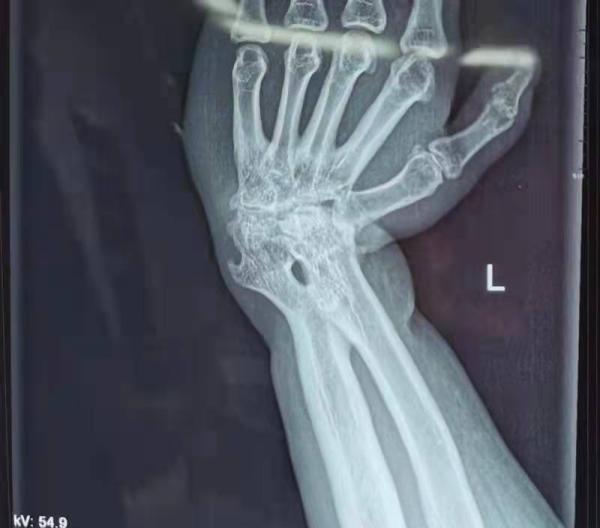The artificial wrist prosthesis developed by Shanghai Minimally Invasive Bone Research Institute was successfully applied to wrist prosthesis replacement in a hospital in Kunming recently. After undergoing surgery, a patient with severe wrist joint deformity was able to rotate his wrist normally again after a gap of 18 years. The development of prostheses in small joints such as the wrist joint is very difficult, and the Minimally Invasive Orthopedic Department has cooperated with clinicians to tailor different prostheses for patients, and has provided dozens of patients with "personal precision customization" surgical solutions for wrist prosthesis replacement.
Professor Xu Yongqing of the Institute of Trauma and Orthopedics of the 920th Hospital of the Kunming People's Liberation Army Joint Logistics Support Force introduced that this patient was improperly treated after the wrist joint injury 18 years ago, and became ill for a long time, and after diagnosis, the two rows of wrist bones were seriously deformed, and accompanied by missing wrist bones and poor soft tissues, resulting in wrist inability to move. In response to this complex condition, Xu Yongqing's team decided to use a minimally invasive orthopedic customized artificial wrist joint prosthesis for surgery. The interface between this wrist prosthesis and bone binding has a 3D printed bone trabeculature structure, which has good osseointegration performance, which is conducive to the patient's postoperative rehabilitation and long-term stability of wrist function.

Preoperative imaging of the patient's wrist
Thanks to the precise soft tissue repair technology and the stable performance of the wrist prosthesis, the patient is now recovering well, and his wrist has been able to successfully grasp the corn. "The surgery went well and it is expected that this patient will be able to regain a variety of abilities for daily life after a full recovery after surgery." Xu Yongqing said, "Wrist prosthesis customized according to the patient's physiological characteristics and living habits, combined with customized surgical tools, can not only make the operation smoother, but also reduce complications such as infection after surgery, and is more conducive to postoperative rehabilitation." ”
Postoperative imaging at the patient's wrist
According to reports, compared with the large joint prosthesis used for hip and knee replacement, the development of prostheses in small joints such as wrist joints is more difficult. The wrist joint includes three parts: radial wrist joint, carpal median joint and wrist palmar joint, which is small in size, complex adjacent relationship and complex anatomy of surrounding soft tissues, which requires high precision in daily rotation and flexion and extension movements. Therefore, in order to develop a prosthesis that conforms to the normal anatomy of the wrist joint, the scientific research team faces great challenges in terms of prosthetic materials and prosthetic structure design.
The more mature wrist replacement prosthesis generally adopts the design scheme of replacing the radius wrist joint, which can improve the function of the radius wrist area of the patient. The function of the wrist joint is mainly concentrated in the joint area of the wrist, which is most closely related to human activity, and the prosthesis replacement scheme for replacing the joint in the wrist is more complex, but it is more ideal for patients. Under the current objective conditions, most patients with wrist joint diseases in mainland China can only receive conservative treatment or fusion treatment programs, and cannot achieve a complete recovery of wrist joint function.
In view of this pain point, the Department of Minimally Invasive Orthopedics has cooperated with Professor Xu Yongqing's team to carry out clinical research on the research and development of artificial wrist replacement prosthesis since June 2020. This prosthesis can realize the most important wrist joint function reconstruction in the patient's wrist joint, and tailor different prostheses for patients through the reconstruction of patient anatomical data, personalized wrist joint protocol design, medical interaction, 3D printing technology and traditional processing methods.
Up to now, the artificial wrist prosthesis of the minimally invasive orthopedic department has achieved dozens of clinical implants. Through the accumulation of wrist anatomy data of Chinese people, the company is transforming the clinical research topic into a matching wrist prosthesis that is more in line with the anatomy of Chinese patients, so that more patients can restore the normal movement of the joint.
Column Editor-in-Chief: Huang Haihua Text Editor: Yu Taoran
Source: Author: Yu Taoran